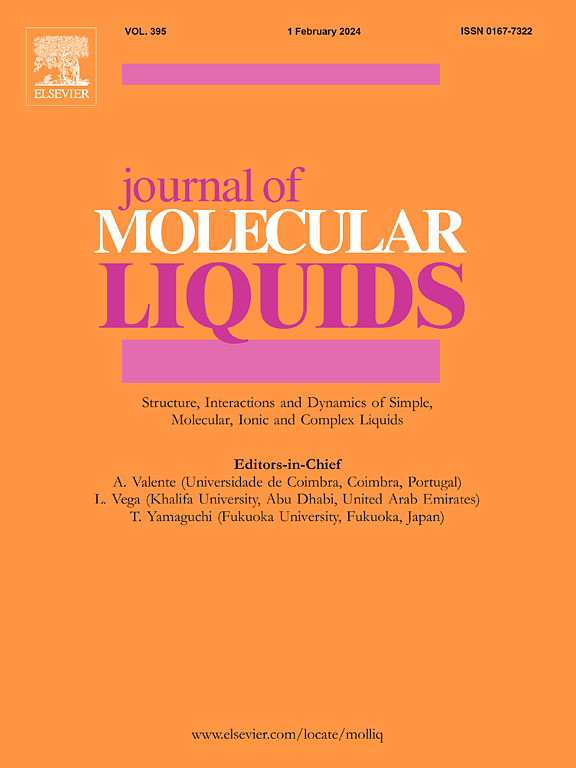金属-有机骨架-5 (SnO2/MOF-5)上SnO2量子点(QD)的发展:表征、光催化降解铬黑t的可行性及途径
IF 5.3
2区 化学
Q2 CHEMISTRY, PHYSICAL
引用次数: 0
摘要
本研究采用溶剂-热沉淀法合成了在[zn40o (BDC)3]金属-有机骨架-5 (SnO2/MOF-5)上修饰的纳米氧化锡颗粒(SnO2)纳米复合材料。该纳米复合材料对铬黑T (EBT)具有优异的催化降解能力。TG-DTG、XRD、BET、BJH、FE-SEM、FT-IR、UV-VIS DRS、PL和EDX等技术对合成样品进行了表征。基于Scherrer和Williamson-Hall方法,纳米复合材料样品的平均晶粒尺寸分别为43.3 nm和65.0 nm。通过对SnO2和SnO2(30% wt)/MOF-5样品的pHpzc测量,这些样品的pHpzc值分别约为7.7和7.8。实验表明,MOF-5、SnO2和SnO2(30% wt)/MOF-5样品的吸收边缘分别为328、456和350 nm,带隙能量分别为3.78、2.71和3.54 eV。实验结果表明,在SnO2(30% wt)/MOF-5: 1 g/L, pH: 5.0的最佳操作参数下,10 mg/L EBT可以被完美降解。与其他二元光催化剂相比,SnO2(30% wt)/MOF-5表现出最优异的光催化性能。具有高电子迁移率的宽带隙n型SnO2半导体与MOF-5的高表面积(高达3000 m2/g)和有序孔隙度的结合改善了反应动力学。加入的SnO2的高化学和机械稳定性形成了一个保护界面,减轻了MOF-5在水或恶劣环境中的降解。为了获得最佳的助推效果,二元催化剂的SnO2/MOF-5质量比必须为30% wt(最佳为30% wt)。结果表明,光降解动力学符合Hinshelwood模型(k = 0.011 min−1,t1/2 = 58.72 min)。对光降解EBT溶液进行COD分析,得到斜率为0.025 min−1 (t1/2 = 27.72 min)的Hinshelwood图。尽管连续四个反应周期,使用SnO2 (30 wt%)/MOF-5可重复使用后,没有明显的性能下降迹象。本文章由计算机程序翻译,如有差异,请以英文原文为准。
The development of SnO2 quantum dots (QD) on metal–organic framework-5 (SnO2/MOF-5): Characterization, feasibility and pathways in photocatalytic degradation of Eriochrome Black t
This study synthesizes a nanocomposite of nanosized Stannic oxide particles (SnO2) decorated on [Zn4O (BDC)3] metal–organic framework-5 (SnO2/MOF-5) using a facile solvent-thermal precipitation technique. This nanocomposite has outstanding catalytic degradation capabilities for Eriochrome Black T (EBT). TG-DTG, XRD, BET, BJH, FE-SEM, FT-IR, UV–VIS DRS, PL, and EDX techniques characterized the as-synthesized samples. Based on Scherrer and Williamson-Hall methods, the average crystallite size of the nano-composite samples was 43.3 nm and 65.0 nm, respectively. As a result of pHpzc measurements on SnO2 and SnO2(30 %wt)/MOF-5 samples, the pHpzc values of these samples were approximately 7.7 and 7.8, respectively. Our experiments showed that MOF-5, SnO2, and SnO2(30 %wt)/MOF-5 samples exhibit absorption edges of 328, 456, and 350 nm, respectively, associated with bandgap energies of 3.78, 2.71, and 3.54 eV, respectively. Based on the experimental parameters, it has been confirmed that 10 mg/L EBT can be degraded perfectly at these optimum operational parameters: SnO2(30 %wt)/MOF-5: 1 g/L, pH: 5.0. In comparison with other binary photocatalysts, SnO2(30 %wt)/MOF-5 showed the most impressive photocatalytic performance. The combination of the wide bandgap n-type SnO2 semiconductor, having a high electron mobility, with MOF-5′s high surface area (up to 3000 m2/g) and ordered porosity improves the reaction kinetics. The high chemical and mechanical stability of incorporated SnO2 forms a protective interface, mitigating MOF-5′s degradation in aqueous or harsh environments. For the best-boosting effect, the binary catalyst’s SnO2/MOF-5 mass ratio must be 30 %wt (optimum: 30 %wt). Observations revealed that the photodegradation kinetics followed the Hinshelwood model (k = 0.011 min−1, t1/2 = 58.72 min). As a result of COD analysis on photodegraded EBT solutions, a Hinshelwood plot was obtained with a slope of 0.025 min−1 (t1/2 = 27.72 min). Despite four consecutive reaction cycles, there was no noticeable sign of performance decay after using SnO2 (30 wt%)/MOF-5 for reusability.
求助全文
通过发布文献求助,成功后即可免费获取论文全文。
去求助
来源期刊

Journal of Molecular Liquids
化学-物理:原子、分子和化学物理
CiteScore
10.30
自引率
16.70%
发文量
2597
审稿时长
78 days
期刊介绍:
The journal includes papers in the following areas:
– Simple organic liquids and mixtures
– Ionic liquids
– Surfactant solutions (including micelles and vesicles) and liquid interfaces
– Colloidal solutions and nanoparticles
– Thermotropic and lyotropic liquid crystals
– Ferrofluids
– Water, aqueous solutions and other hydrogen-bonded liquids
– Lubricants, polymer solutions and melts
– Molten metals and salts
– Phase transitions and critical phenomena in liquids and confined fluids
– Self assembly in complex liquids.– Biomolecules in solution
The emphasis is on the molecular (or microscopic) understanding of particular liquids or liquid systems, especially concerning structure, dynamics and intermolecular forces. The experimental techniques used may include:
– Conventional spectroscopy (mid-IR and far-IR, Raman, NMR, etc.)
– Non-linear optics and time resolved spectroscopy (psec, fsec, asec, ISRS, etc.)
– Light scattering (Rayleigh, Brillouin, PCS, etc.)
– Dielectric relaxation
– X-ray and neutron scattering and diffraction.
Experimental studies, computer simulations (MD or MC) and analytical theory will be considered for publication; papers just reporting experimental results that do not contribute to the understanding of the fundamentals of molecular and ionic liquids will not be accepted. Only papers of a non-routine nature and advancing the field will be considered for publication.
 求助内容:
求助内容: 应助结果提醒方式:
应助结果提醒方式:


